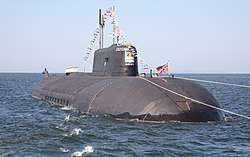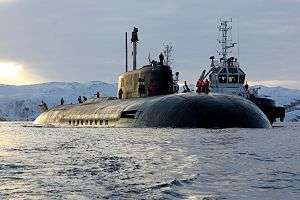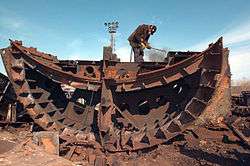Oscar-class submarine
The Oscar class, Soviet designations Project 949 Granit and Project 949A Antey, (NATO reporting names Oscar I and Oscar II respectively), are a series of nuclear-powered cruise missile submarines designed in the Soviet Union for the Soviet Navy. They are currently in service with the Russian Navy with some of the vessels planned to be modernized as Project 949AM, to extend their service life and increase combat capabilities.
 K-150 Tomsk in Vilyuchinsk | |
| Class overview | |
|---|---|
| Name: | Oscar class |
| Builders: | Sevmash |
| Operators: | |
| Preceded by: | Papa class |
| Succeeded by: | Yasen class |
| Built: | 1975–present |
| In commission: | 1980–present |
| Planned: | 20 (2 949, 18 949A)[1] |
| Completed: | 14 (2 949, 11 949A, 1 09852) |
| Cancelled: | 6 (2 incomplete, 4 never laid down) |
| Active: | 6 (+2 on modernization to 949AM)[2] |
| Laid up: | 2 |
| Lost: | 1 |
| Retired: | 4 |
| General characteristics | |
| Type: | Nuclear cruise missile submarine |
| Displacement: |
|
| Length: | 155 m (508 ft 6 in)[1] maximum |
| Beam: | 18.2 m (59 ft 9 in) |
| Draught: | 9 m (29 ft 6 in) |
| Installed power: | 2 × pressurized water cooled reactors |
| Propulsion: | 2 × steam turbines delivering 73,070 kW (97,990 shp) to two shafts |
| Speed: |
|
| Endurance: | 120 days[1] |
| Test depth: | 830 m |
| Complement: | 94/107[1] |
| Armament: |
|
The Project 949 submarines were the largest cruise missile submarines in service until the Ohio-class ballistic missile submarines were converted to carry cruise missiles in 2007. They are the fourth largest class of submarines in displacement and length. Only the Soviet Typhoon-class, Russian Borei-class and American Ohio-class ballistic missile submarines are larger.
History
The first submarine of Project 949 was laid down in the mid-1970s and was commissioned in 1980. In 1982 an updated and larger version (Project 949A) replaced the earlier version. In total thirteen submarines were constructed. The Oscar class was designed to attack NATO carrier battle groups using long-range SS-N-19 "Shipwreck" anti-ship missiles and targeting data provided by the EORSAT satellite system (via the submarine's "Punch Bowl" antenna).[4][5][6] In the financial problems that followed the fall of the Soviet Union the Oscar class was prioritized by the Russian Navy and when many older submarine classes were retired the Oscar class remained active in both the Northern and Pacific Fleets.
Modernization
The Rubin Design Bureau started working on Project 949A modernization in 2011, with Zvezdochka and Zvezda shipyards to carry out modernization of the vessels.[7] In September 2015, Russian Defence Minister Sergey Shoygu announced during his visit to Zvezda shipyard, that at least three Oscar-class submarines will undergo repair and modernization to extend their service life by 20 years.[8] The upgraded submarines will be known as "Project 949AM", according to the Russian officials. Modernization cost was estimated at RUB12 billion (US$182 million) per submarine.[9]
In September 2016, it was reported submarines K-132 Irkutsk and K-442 Chelyabinsk are currently being modernized to 949AM.[10] According to the Deputy Prime Minister of Russia Yury Borisov, Russia's Pacific Fleet may get four modernized Oscar II-class submarines armed with Kalibr cruise missiles by 2021.[11]
Versions
Project 949 Granit (Oscar I)
Two Project 949 Granit submarines were built at Severodvinsk between 1975 and 1982 and assigned to the Soviet Northern Fleet. K-525 was laid down in 1975 and K-206 was laid down in 1979. After the construction of the first two submarines, production continued with the improved project 949A Antey. Both submarines of the Project 949 were decommissioned in 1996[12] and scrapped in 2004.[13]
Project 949A Antey (Oscar II)
Eleven Project 949A Antey submarines were completed at Severodvinsk, of which five were assigned to the Soviet Northern Fleet. At one stage it had been planned to develop a new fourth-generation follow-on to the Project 949A, but this plan was later dropped. The external differences between the two classes were that the 949A class is about 10 metres (33 ft) longer than its predecessor (approximately 154 metres, 505 ft rather than 143 m, 469 ft), providing space and buoyancy for improved electronics and quieter propulsion.
Some sources speculate that the acoustic performance of the Oscar II class is superior to early Akula class but inferior to the Akula II class as well as subsequent (4th generation) designs.[14] It also has a larger fin, and its propellers have seven blades instead of four.[15]
Like all post-World War II Soviet designs, they are of double hull construction.[16] Similarly, like other Soviet submarine designs, Project 949 not only has a bridge open to the elements on top of the sail but, for use in inclement weather, there is an enclosed bridge forward and slightly below this station. A distinguishing mark is a slight bulge at the top of the fin. A large door on either side of the fin reaches this bulge. These are wider at the top than on the bottom, and are hinged on the bottom. The Federation of American Scientists[15] reports that this submarine carries an emergency crew escape capsule; it is possible that these doors cover it. The VSK escape capsule can accommodate 110 people.[17]
Project 949AM
Modernization of Project 949A submarines, first announced by the Russian Defence Ministry in 2011.[7] As part of the modernization, submarines will have their 24 P-700 Granit anti-ship missiles replaced with up to 72 newer 3M-54 Kalibr or P-800 Oniks anti-ship cruise missiles. The upgrade requires no design changes to the hull as the new missiles will fit into the existing launchers outside the pressure hull. The modernized boats will also get upgraded Omnibus-M combat information and Simfoniya-3.2 navigation systems, as well as new fire-control system, communications, sonar, radar, and electronic intercept equipment.[9] The modernization aims to bring the submarines up to the same technological level as the Russia's next-generation Yasen-class nuclear-powered cruise missile submarines.[8]
Project 09852
In December 2012, construction began on a special purpose research and rescue submarine, designated Project 09852, and based on the incomplete Project 949A (Oscar II class) submarine Belgorod.[18][19][20] The submarine is reportedly designed to carry both manned (e.g. Project 18511 midget submarine) as well as unmanned (e.g. Klavesin-1R) underwater vessels.[19][21] However, while carrying smaller unmanned underwater vehicles (UUVs) would be possible as-is on an Oscar-class hull, the accommodation of a midget submarine such as Project 18511 Paltus or the even larger Project 10831 Losharik,[22] would probably require a major hull extension in order to accommodate a docking compartment. For example, the length of the submarine BS-64 Podmoskovye was increased by 9 metres (30 ft) even though the SLBM missile compartment was completely removed.[23][24]
Belgorod will be reportedly used as a carrier of the rumored Poseidon (NATO reporting name Kanyon) nuclear-powered, nuclear armed unmanned underwater device capable to carry a 100 Mt nuclear warhead, with at least four such devices being carried horizontally in place of the 24 P-700 Granit (SS-N-19 Shipwreck) launchers for a total yield of 600 megatonnes.[21][25][26][27]
It is estimated that Belgorod will be 184 metres (604 ft) long which would make it the longest submarine in the world.[21][28][29]
On 23 April 2019, Belgorod was floated out of a slipway during a ceremony at the Sevmash shipyard, watched by the Russian President Vladimir Putin via a TV-link. Further work will be completed afloat and the submarine is scheduled to start its factory and state trials in 2020 after it will be delivered to the Russian Navy.[30][31]
Units
| No | Name | Project | Laid down | Launched | Commissioned | Fleet | Status |
|---|---|---|---|---|---|---|---|
| K-525 | Arkhangelsk (ex-Minskiy Komsomolets) |
949 | 25 July 1975 | 3 May 1980 | 30 December 1980 | Northern | Decommissioned 1996,[12] scrapped in 2004[13] |
| K-206 | Murmansk | 949 | 22 April 1979 | 10 December 1982 | 30 November 1983 | Northern | Decommissioned 1996,[12] scrapped in 2004[13] |
| K-148 | Krasnodar | 949A | 22 July 1982 | 3 March 1985 | 30 September 1986 | Northern | Retired, scrapping began in late 2012[32] |
| K-173 | Krasnoyarsk | 949A | 4 August 1983 | 27 March 1986 | 31 December 1986 | Pacific | Inactive, caught fire during scrapping[33] |
| K-132 | Irkutsk | 949A | 8 May 1985 | 27 December 1987 | 30 December 1988 | Pacific | Currently being modernized to 949AM at Zvezda shipyard[34][36] |
| K-119 | Voronezh | 949A | 25 February 1986 | 16 December 1988 | 29 December 1989 | Northern | Active, after overhaul completed in November 2011[37] |
| K-410 | Smolensk | 949A | 9 December 1986 | 20 January 1990 | 22 December 1990 | Northern | Active, after overhaul completed in December 2013[38][39] |
| K-442 | Chelyabinsk | 949A | 21 May 1987 | 18 June 1990 | 28 December 1990 | Pacific | Currently being modernized to 949AM at Zvezda shipyard[36] |
| K-456 | Tver (ex-Vilyuchinsk) |
949A | 9 February 1988 | 28 June 1991 | 18 August 1992 | Pacific | Active |
| K-266 | Orel (ex-Severodvinsk) |
949AM | 19 January 1989 | 22 May 1992 | 30 December 1992 | Northern | Active, after overhaul completed in April 2017[40][41] |
| K-186 | Omsk | 949A | 13 July 1989 | 10 May 1993 | 15 December 1993 | Pacific | Active, after overhaul completed in 2008[42][43][44] |
| K-150 | Tomsk | 949A | 27 August 1991 | 20 July 1996 | 30 December 1996 | Pacific | Active, after overhaul completed in 2019[45][46][47] |
| K-141 | Kursk | 949A | 22 March 1992 | 16 May 1994 | 30 December 1994 | Northern | Lost on 12 August 2000 |
| K-329 | Belgorod | 09852 | 24 July 1992 | 23 April 2019[30] | 2020 | Floated out, converted for special missions[48][29] | |
| K-135 | Volgograd | 949A | 2 September 1993 | Unfinished, parts used in the construction of newer submarines[49] Construction may be restarted | |||
| K-165 | Barnaul | 949A | April 1994 | Unfinished, parts used in the construction of newer submarines[49] Construction may be restarted |
Gallery
 This picture clearly displays the arrangement of the hatches in the hull above the missile tubes, on either side of the dorsal fin. Also shown is the opening for the forward hydroplane (currently folded in), as well as the bulge on the top of the fin under which the rescue capsule is located. Although partially obscured by shadow, the seam between the capsule and the fin is faintly visible.
This picture clearly displays the arrangement of the hatches in the hull above the missile tubes, on either side of the dorsal fin. Also shown is the opening for the forward hydroplane (currently folded in), as well as the bulge on the top of the fin under which the rescue capsule is located. Although partially obscured by shadow, the seam between the capsule and the fin is faintly visible. K-186 Omsk during 2008 Naval Parade in Vladivostok
K-186 Omsk during 2008 Naval Parade in Vladivostok K-266 Orel after completion of its overhaul
K-266 Orel after completion of its overhaul Disassembling of an Oscar-class submarine at the Zvezdochka shipyard in Severodvinsk, Russia
Disassembling of an Oscar-class submarine at the Zvezdochka shipyard in Severodvinsk, Russia Artist impression of a Soviet ballistic missile submarine base during the 1980s
Artist impression of a Soviet ballistic missile submarine base during the 1980s
See also
References
- Podvodnye Lodki, Yu.V. Apalkov, Sankt Peterburg, 2002, ISBN 5-8172-0069-4
- "ЦАМТО / Новости / До 2025 года Минобороны РФ намерено модернизировать 4 атомные подлодки для ТОФ". www.armstrade.org. Archived from the original on 2017-06-09. Retrieved 2017-07-12.
- Siddiqi, Asif (November 1999). "Staring at the Sea: The Soviet RORSAT and EORSAT Programmes" (PDF). Journal of the British Interplanetary Society. 52 (11): 397–416. Archived (PDF) from the original on 2015-01-03. Retrieved 2013-07-06.
- "data" (JPG). i.imgur.com. Archived from the original on 2016-08-26. Retrieved 2016-08-13.
- "SSGN Oscar II Class (Project 949.A) (Kursk) – Naval Technology". naval-technology.com. Archived from the original on 2013-08-14. Retrieved 2013-07-06.
- "Атомные подлодки проекта "Антей" пройдут перевооружение". lenta.ru. 12 December 2011. Archived from the original on 11 March 2016. Retrieved 4 March 2019.
- "Russia details ambitious effort to modernise nuclear-powered submarines to bolster order of battle". Archived from the original on 2 December 2015. Retrieved 4 March 2019.
- "Russia initiates multiyear plan to modernise Oscar II SSGNs". Archived from the original on 2016-05-21. Retrieved 4 March 2019.
- "Russia to upgrade only part of nuclear-powered Antey submarines". TASS. 29 September 2016. Archived from the original on 30 December 2018. Retrieved 4 March 2019.
- "Russia's Pacific Fleet to get four upgraded nuclear subs by 2021". TASS. 6 February 2018. Archived from the original on 6 March 2019. Retrieved 4 March 2019.
- "Oscar 1 class". Military Today. Archived from the original on 2012-05-10. Retrieved 2011-12-30.
- "Zvezdochka dismantling two nuclear subs". Bellona Foundation. 2 April 2004. Archived from the original on 22 March 2012. Retrieved 30 December 2011.
- "China's Noisy Nuclear Submarines » FAS Strategic Security Blog". Fas.org. Archived from the original on 2014-07-15. Retrieved 2013-03-24.
- "Project 949 Granit / Oscar I ; Project 949A Antey / Oscar II". Federation of American Scientists. Archived from the original on 2011-12-27. Retrieved 2011-12-30.
- "949 /A Oscar I/II class". warfare.be. Retrieved 1 January 2012.
- "A Mystery In The Deep". The Daily Beast. Archived from the original on 16 January 2012. Retrieved 6 September 2017.
- "Project 09852". www.deagel.com. Archived from the original on 2016-12-28. Retrieved 2016-12-26.
- "Russia builds deep-sea research submarine". World-nuclear-news.org. 2012-12-21. Archived from the original on 2013-02-13. Retrieved 2013-02-06.
- "Russia builds nuclear submarine for deep-water research". Barents Observer. Archived from the original on 3 April 2013. Retrieved 29 April 2013.
- "Spy Subs -Project 09852 Belgorod". hisutton.com. Archived from the original on 23 April 2019. Retrieved 23 April 2019.
- John Pike. "Project 210 Losharik". Globalsecurity.org. Archived from the original on 2012-12-26. Retrieved 2013-02-06.
- "Archived copy". Archived from the original on 2017-02-12. Retrieved 2016-12-26.CS1 maint: archived copy as title (link)
- "Barentsobserver". Barentsobserver. Archived from the original on 2015-08-22. Retrieved 2016-12-26.
- "Analysis - Russian Status-6 aka KANYON nuclear deterrence and Pr 09851 submarine". hisutton.com. Archived from the original on 17 February 2019. Retrieved 23 April 2019.
- "Russia's nuclear underwater drone is real and in the Nuclear Posture Review". defensenews.com. 12 January 2019. Retrieved 23 April 2019.
- "The Truth Behind Russia's 'Apocalypse Torpedo'". popularmechanics.com. 18 January 2019. Archived from the original on 30 March 2019. Retrieved 23 April 2019.
- "Now, Russia builds a submarine even bigger than the Typhoon". thebarentsobserver.com. 3 May 2017. Archived from the original on 29 September 2018. Retrieved 23 April 2019.
- "Russian Navy to Receive Biggest and Most Unique Nuclear Submarine in the World". Sputnik (news agency). 23 April 2017. Archived from the original on 6 May 2019. Retrieved 23 April 2019.
- "Russia floats out first nuclear sub that will carry Poseidon strategic underwater drones". TASS. 23 April 2019. Archived from the original on 23 April 2019. Retrieved 23 April 2019.
- Rogers, James (2019-04-24). "Russia launches huge 'doomsday' supersub". Fox News. Archived from the original on 2019-04-24. Retrieved 2019-04-24.
- "Nerpa Shipyard Starts Dismantling of Nuc Sub Krasnodar". rusnavy.com.
- "Soviet-Era Nuclear Submarine Catches Fire During Disassembly". Archived from the original on 2016-05-08. Retrieved 2016-05-01.
- "Подводный крейсер К-132, "Иркутск". Проект 949А". www.deepstorm.ru. Archived from the original on 2013-05-11. Retrieved 2012-03-24.
- "Russia to upgrade only part of nuclear-powered Antey submarines". Archived from the original on 2017-07-02. Retrieved 2017-07-12.
- ЦС "Звездочка" завершил ремонт атомного подводного ракетного крейсера К-119 "Воронеж" [CA "Star" completed the renovation of nuclear submarine K-119 "Voronezh"]. flot.com (in Russian). I-mash.ru. Archived from the original on 2012-04-24. Retrieved 2012-01-01.
- "Repair Works Started on SSN Smolensk". rusnavy.com.
- Ольга ЕФРЕМОВА - Сайт «Комсомольской правды» (31 December 2013). "Атомоход "Смоленск" в 2014 году посетит Северный полюс". Archived from the original on 29 July 2017. Retrieved 12 July 2017.
- "Подводный крейсер "Орел" отправился к месту базирования". 6 April 2017. Archived from the original on 6 April 2017. Retrieved 6 April 2017.
- "Nuclear-powered Oscar-class submarine returns to Russian fleet". 11 April 2017. Archived from the original on 2017-07-02. Retrieved 2017-07-12.
- "Defense shipyard Zvezda claims RUR 65 mln for repairs of SSGN Omsk". rusnavy.com. 7 September 2010. Archived from the original on 5 February 2012. Retrieved 1 January 2012.
- "Court obliged Pacific Fleet to pay for repair of SSN Omsk". rusnavy.com. 8 April 2011. Archived from the original on 5 February 2012. Retrieved 1 January 2012.
- "Подводный крейсер К-186, "Омск". Проект 949А". www.deepstorm.ru. Archived from the original on 2017-07-13. Retrieved 2017-07-12.
- "PRESS-CENTER". dcss.ru. Archived from the original on 2017-07-26. Retrieved 2017-07-12.
- "Nuclear submarine Tomsk returns to Kamchatka naval base having completed naval combat training tasks : Ministry of Defence of the Russian Federation". eng.mil.ru. Archived from the original on 2016-01-31. Retrieved 2016-01-24.
- http://www.armstrade.org/includes/periodics/news/2019/0809/100553803/detail.shtml
- "Russia to Convert Belgorod Submarine for Special Missions". Sputnik (news agency). 9 February 2012. Archived from the original on 23 April 2019. Retrieved 23 April 2019.
- Лодки с крылатыми ракетами Archived 2016-08-13 at the Wayback Machine defendingrussia.ru
Bibliography
- The Encyclopedia Of Warships, From World War Two To The Present Day, General Editor Robert Jackson.
External links
| Wikimedia Commons has media related to Oscar class submarines. |
- "The Kursk Crisis". deepspace4.com. 23 August 2000. Archived from the original on 18 July 2011.
- "Oscar-class subs and Soviet RORSATs". Friends and Partners. 1 September 2000.
- Line drawing of Oscar-class submarine